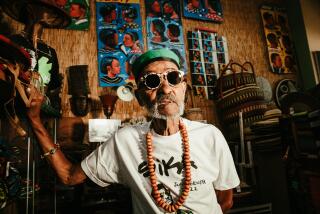Love of Art Was the Bottom Line for Newport Harbor’s Jack Shea
- Share via
With the death last week of Jack Shea, Newport Harbor Art Museum trustee extraordinaire, Orange County lost a member of an increasingly endangered species: business people who support art primarily because it is their passion.
Shea, who died Feb. 5 at age 74 in Palm Springs after a long illness, was president of the museum’s board from 1978-81 and 1986-87.
It was during his final term I came to know him--as well as any member of the press could know a famously reserved man whose soft-spoken comments were invariably succinct, to the point of terseness.
Shea’s brother was a partner in the Locksley-Shea Gallery in Minneapolis--one of the few in the Midwest dedicated in the ‘60s to contemporary art--and Shea frequently flew out for a visit.
“Out of every show, I’d acquire one or two paintings,” Shea told me during a 1985 interview. “And I got to know all the artists.”
Frank Stella--whose massive 1968 painting “Harran III,” from his Protractor series, hangs in the living room of Jack and Marion Shea’s Palm Springs home--was the guest of honor at a party the couple gave years ago.
“He looked at [his painting] and walked away,” Shea recalled. His puzzlement at this behavior turned to gratitude when Stella waited for a private moment to tell him that the painting had been hung incorrectly.
*
Shea, who also kept an apartment in Newport Beach, had his Palm Springs house designed in the late ‘70s to fit his painting collection, which included work by many of the luminaries of post-World War II art. Even so, he was obliged to build in a new wall to accommodate the 20-foot Stella, and had to hang Morris Louis’ veil painting “Beth Shiba” over a window to give it enough room.
When I visited, the living room and “garden room” also contained signature pieces by such major artists as Ellsworth Kelly, Roy Lichtenstein, Mark Rothko, Helen Frankenthaler, Jasper Johns, Robert Motherwell, Brice Marden, Franz Kline, Ad Reinhardt and Sam Francis. The rest of the house was alive with art too, from the lithographs in the bath and kitchen to the sculptures near the pool.
Shea particularly liked big art, a taste that meshed well with the outsized canvases of the Color Field painters of the ‘60s.
Like most passionate art collectors, he bought purely for enjoyment, not with an eye toward investment potential.
“I honestly don’t take a financial inventory every month or every year,” he said.
Still, he took a certain delight in observing that that the Cy Twombly painting he bought for $1,800 in 1969--his first acquisition--would have cost at least $150,000 in the mid-’80s.
A frequent art-museum visitor, especially when he visited New York, Shea kept up with the art magazines (scorning what he called the “obtuse” writing, he just looked at the pictures) and relied on a few big-city art dealers--”bird dogs” as he called them--to locate work that suited his taste.
Shea’s acquisitions eventually became too numerous to display at home. He candidly remarked in the interview that the ones he no longer cared for would go to Newport Harbor. (Among Shea’s donations were paintings by Billy Al Bengston, Ron Davis, Tom Holland and other California artists.)
Through his Newport Beach-based chain of car washes, Beacon Bay Enterprises Inc., Shea supported Newport Harbor’s admission-free Tuesdays and several exhibitions, including “The Second Newport Biennial: The Bay Area” in 1986.
*
Reserved as he was, Shea was not shy about demanding some limelight for his support. A museum spokeswoman would call at his behest to prod any errant art writer who didn’t give him proper credit.
Shea’s 1986-87 term as board president coincided with a golden time for the institution, when chief curator Paul Schimmel was conceiving exhibitions of national prominence, grants were rolling in from public and corporate sources, and the museum collection was expanding at a gratifying rate.
In hindsight, however, it may be that Shea’s most important contribution to the museum was to set an example of businessperson as art collector.
By combining a genuine passion for art, a good “eye” and impeccable taste with savvy contacts and advisors, he was the perfect liaison between the art professionals who ran the museum and the business people whose support allowed it to thrive. Would that all museum trustees were similarly endowed.
More to Read
The biggest entertainment stories
Get our big stories about Hollywood, film, television, music, arts, culture and more right in your inbox as soon as they publish.
You may occasionally receive promotional content from the Los Angeles Times.










